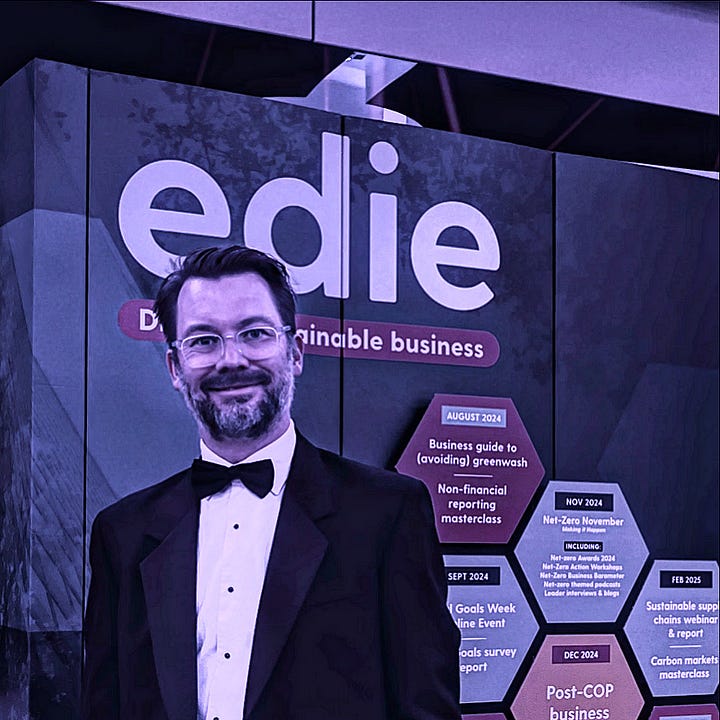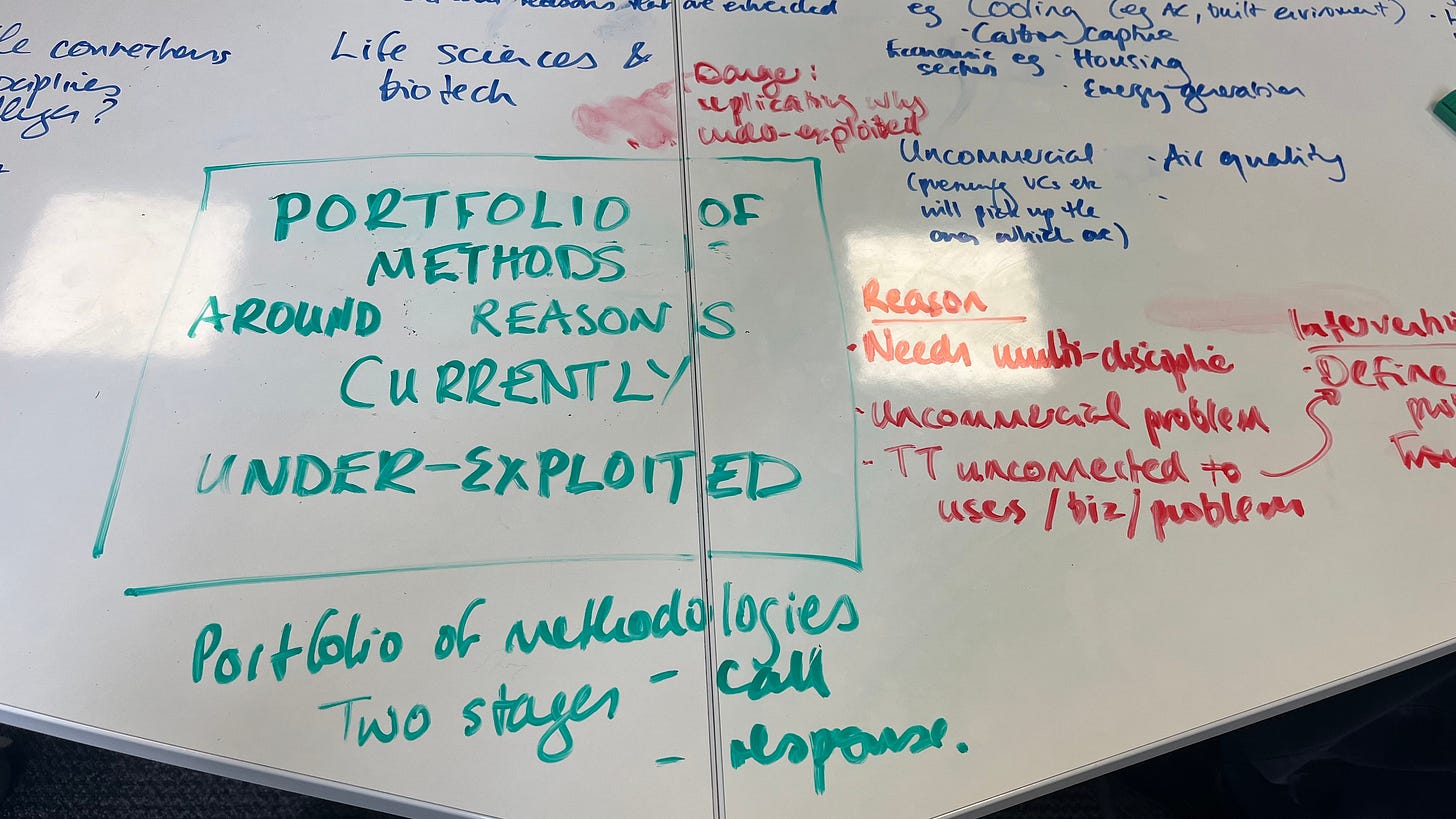Atelier WeekNotes w/c 4 Mar 2024
edie Awards. Kickstarting Undaunted's Climate Solutions Catalyst.
I am writing newsletter of #weeknotes of starting the Atelier of What’s Next (a studio for initiatives at the frontier of generating a better future). For my rationale for starting the Atelier see here.
This week covers:
0/DETECTING:
edie Awards: what mainstreaming looks like.
Kickstarting Undaunted's Climate Solutions Catalyst. Reflections:
Diagnosing explicitly is a vital step.
Framing is crucial: 'commercialising' is only a subset of 'implementing'.
Problems are not markets. Problems Are Not Markets. PROBLEMS. ARE. NOT. MARKETS.
Huge danger of replicating the dynamics of under-exploitation.
Success: an on-going community for serendipity.
How: portfolio of interventions, each addressing specific hypothesis on why research finding is under-used.
How can the Atelier of What's Next be of service to you, and your purposes? We'd love to hear from you. Perhaps you have a challenge or idea to put in the studio. Maybe one of our existing topics appeals to you. What if you love to make new things happen by being part of the studio? Or if you have feedback or comments that would improve this deck. Either click the button below or email davidbent@atelierwhatsnext.org.
Priorities
No progress on the two priorities (oops):
1. Offering-challenge-resourcing fit.
2. Organising for abundance.
0/DETECTING
edie Awards
On Wednesday evening I was at the edie Awards, 'recognising the people, projects & partnerships transforming business, for good'.
It was a big, black tie event, with a keynote speaker of Caroline Lucas, the Green MP who is stepping down at the next election. I had been a judge a couple of months ago, as an senior associate to Skating Panda, the creative social impact consultancy I sometimes work with.


After the judging I had some reflections on the Skating Panda website here, on:
The expanding meaning of 'sustainability' over the 17 years of the awards, from just focusing on environment to now the whole waterfront.
The greater depth and quality of entries. I was lead judge on SMEs, who are doing things now that leading companies were not doing in 2007.
Better is still not good enough, unfortunately.
Advice from a judge weary of reading that "sustainability is in our DNA" and similar cliches.
My reflection about the night was: this is what mainstreaming looks like.
Some 650 people, in black tie, in a fancy London hotel's ballroom. Having a 4 course meal, paying for a table for the whole team so you can bond and let your hair down. A top-tier comic does a set and then presenting the awards. Loud music, big screens, yet another round of applause as folks make their way from table 39 to the front. A grip, a grin, a flash of light for the photo and then next.
It could have been any industry's awards ceremony, except for a completely vegan meal. And except from the main speaker, Caroline Lucas, saying that the modern economic model of perpetual growth is broken, and business leadership is needed to take us away from that. (Good luck with that, Caroline.)
Broadly, I think adopting the badges of legitimacy is a good thing for sustainable business. We need to support a climate-concerned majority of businesses to respond meaningful to our emergency, in a similar way as Climate Majority Project is with citizens.
It comes with a sadness though. This year Caroline Lucas and last year Rachel Kyte (video here) both used their speeches to challenge the status quo framing of a smooth, technocratic sustainability transition happening within the existing paradigm. I know both speeches went down well in the hall (Rachel's in particular last year).
Such radical perspective is not represented in the awards categories themselves. Yet. Such is the social process of change. In terms of the Overton Window (Unthinkable -> Radical -> Acceptable -> Sensible -> Popular), the categories are what is acceptable today but was radical yesterday. Perhaps what is radical today can become the acceptable awards categories from next year.
WHAT NEXT. If invited, be a judge later in the year (wearing my Skating Panda hat).
Kickstarting Undaunted's Climate Solutions Catalyst
I was a participant in a half-day workshop kickstarting Undaunted's Climate Solutions Catalyst.
Undaunted is Imperial College's climate innovation effort (my phrasing). Their phrasing: "Undaunted is fostering a thriving innovation ecosystem that aims to make London and the UK a great place to start and scale intelligent, sustainable solutions to the climate challenge at pace". You can hear the Director, Alyssa Gilbert, describe what Undaunted does in this Innovation for Sustainability interview.
(Sidebar: I wish Undaunted would come up with a strapline that I could use to explain them easily, in one sub-clause of a sentence, because the name 'Undaunted' by itself could be a sports drink, a marketing agency or an Instagram influencer. Love the sentiment, hate the ambiguity.)
Anyway. Undaunted has funding from Quadrature Climate Foundation (QCF), to pilot a Climate Solutions Catalyst, "a novel two-year programme that aims to unearth promising yet untapped climate solutions from the UK’s research community".
The briefing note in advance told us that the key hypothesis of the trial phase: the UK research community has already made discoveries and inventions that can help tackle climate change, if only they can be identified and supported properly towards commercial innovation, or other types of impact.
But: what does success look like , and which research fields should we scope? Undaunted brought together 50 or so people from the academic research community and adjacencies, like me, to explore those two questions.
My reflections:
Diagnosing explicitly is a vital step.
I find the Design Council Double Diamond very useful for understanding where we are in an innovation process:
Especially via Rowan Conway's 'From Design Thinking to Systems Change', which then led me to develop the fundamental Atelier steps of Detecting, Describing, Discovering, Defining (which I’m reconsidering calling Diagnosing), Developing, Delivering and Driving.
My experience in general is people want to start either with some enormous mapping exercise or get developing. Both of these are flawed, but in different ways.
Mapping leads to, well, a map. But one that is guaranteed to be incomplete and quickly goes out of date. And, unless you are very deliberate, one which describes the situation but does not help you to diagnose it. (See: this diagram on the American strategy in Afghanistan.)
To be able to develop you need a diagnosis which 'boils down the overwhelming complexity to the critical features' (following Rummelt in the must-read Good Strategy Bad Strategy). My experience: mapping leads to a messy diagram which gives you the overwhelming complexity and no way to boil it down.
The other instinct is to get on with developing. But then you risk building on your implicit diagnosis, with assumptions you have about the situation which you haven't even articulated to yourself.
Instead, I believe it is better to start with explicit hypotheses about what will work in the situation. Which, again, puts the emphasis on having a diagnosis, a set of critical features based in what is known.
My feel for the event was that the questions were prompting us to start developing, but without a sense of a specific diagnosis. Presumably, Undaunted have a diagnosis, in order to get the funding. But we as a group didn't hear the detail of it, or work together to create a shared understanding of the different diagnoses we each had.
Instead, asking 'What should success look like?' and 'Which research fields should we scope?' got people to assert things past each other, and not address directly the reason for their different assertions: they have different diagnoses of the situation. A lot of time is then taken up by swimming upstream in the conversation, trying to get to people's implicit assumptions on which their explicit proposals rest.
Framing is crucial; 'commercialising' is only a subset of 'implementing'.
The language used by most of the participants was from the standard tech transfer / VC world. The route to commercialisation that starts with invention in a lab, then public support of a start-up until there is enough evidence of commercial application that private funding can come in. Technology goes through Technology Readiness Levels. All as per the Routes to Commercialisation lecture here.
In this language, one person talked about the purpose of the project as "commercialising under-exploited research findings".
Which implies there is only one way to get impact from under-exploited research findings: selling them as a product or service in a private market, contained within a for-profit enterprise. That provides a narrow lens for looking or attracting under-used findings.
A different framing leads to different answers. Here, avoiding using 'commercialisation' to define how the finding gets used. Instead, talking about implementing and having impact from under-used research findings.
Problems are not markets. Problems Are Not Markets.
Because, because, because, as Rowan Conway keeps telling me (and said in public here): "problems are not markets".
Just because there is a problem, does not mean there will be a market, or revenue available to pay for a product or service that alleviates that problem.
Tropical diseases are a huge problem, especially in sub-Saharan Africa. But the people and countries of that region have far smaller incomes than people in OECD nations. Hence "[health] research output is heavily concentrated in high-income countries and is mainly focused on their health needs, resulting in a relative lack of attention to diseases in lower income countries...Global industrial R&D is found to be very similar to the focus of public research. Diseases more prevalent in high-income countries generate ten-fold more research attention than those in low-income countries." Which is why we need the Drugs for Neglected Diseases Initiative, to develop life-saving medicines for people with neglected diseases around the world.
Lots of climate problems are either very diffuse externalities (no set of individuals affected enough to want to pay for solutions), or affect those with small incomes, or those in the future who cannot pay now, or lots of other reasons why there is no market opportunity which can be pointed to today.
Once more, with feeling: PROBLEMS. ARE. NOT. MARKETS.
Huge danger of replicating the dynamics of under-exploitation.
In the first table discussion on what success looks like, I heard people saying that because the pilot has a 2 year time line, it needs to show results in 2 years. Another group came up with a proposal on how to find the neglected research findings based on evaluating how commercially viable an idea was.
These, and other comments set off, huge alarm bells for me.
If you do what you always did, you'll get what you always got.
What if the reason a research finding got stuck was because there was no market to sell to? Or no route to market in 2 years? (Listen here to climate analyst Michael Liebreich and Prof Donald Sadoway, Professor Emeritus of Materials Chemistry at MIT, talk about how breakthrough technologies based on novel science take 20+ years to reach commercial viability.)
The huge danger in the methods of the initiative is to replicate the dynamics of under-exploitation. By being sensible and using existing approaches, it would not move the dial at all.
Success: an on-going community for serendipity.
OK. Enough ranting. What would success look like? I liked where my table got to, which was:
When it comes to under-used research findings, we don't know what we don't know on both the solution space (what researchers have found) and the problems space (what needs to be done).
Therefore, mapping, analysis and desk research will not get you far enough .
Success would be:
Nurturing an ecosystem of people and organisations for ongoing serendipity (unplanned matching between solutions and problems).
Testing different modes and methods for that serendipity, especially not just 'Undaunted searches out' but also 'Undaunted attracts in'.
Having enough proof points of additionality to open up the next wave of funding.
Research findings on lessons learnt on identifying and supporting under-used research findings.
How: portfolio of interventions, each addressing specific hypothesis.
The second question we were given was: 'Which research fields should we scope?' Every time the table I was at tried to answer, we resisted (not just me, I promise).
Eventually, we realised that this was not the right question. A better question is something like: how can the Climate Solutions Catalyst structure its work so it can have success (and so not just get pulled in every direction or get overwhelmed)?
I liked where my group got to: have a portfolio of interventions, each of which is targeted at a particular reason for a research finding to be under-used.
For instance, several strong voices were of the view that university Tech Transfer offices, which exist to get research findings to be exploited, were fundamentally flawed. Too many had an approach based on 'push technology out'. Instead. what was needed was to 'pull the solutions through'. If that's accurate, then an intervention is to identify a couple of challenge areas, and then go looking for the research findings which would fill particular gaps. Or, perhaps create a competition which attracts the research findings to you, rather than you having to search for them yourself.
A different reason would be that it is only when disciplines mix that people realise that a finding in one field (maths, say) would unlock a finding in a different field (chemistry, say). So, an interventions here would be mixing up people from different disciplines (especially those have good overviews of what has been happening, and what is needed).
The good thing about having a portfolio is that you are not putting everything on 22 and crossing your fingers. By aiming for different types of serendipity, you are increasing your chances of unplanned matching.
But, having different methods in one organisation is complex, cognitively difficult, confusing to outsiders (and insiders) -- and so, it is costly. Whether the pilot can pursue a portfolio it is a big choice.
WHAT NEXT. Wait on news from Undaunted, to see how they want to take the Climate Solutions Catalyst forward.
Additional: Good luck to the Climate Solution Catalyst. Last week I was in a bit of a rush to get the newsletter out last week. As well as the normal (and, I hope, charming) typos, that meant I didn’t make it clear that I think the Climate Solution Catalyst is a good idea that I want to succeed.
My reflection afterwards was you could read the original newsletter without that being clear. Happy to add that now.








